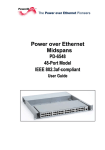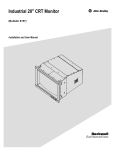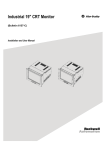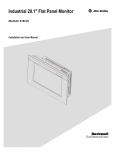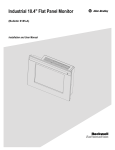Download Rockwell Automation 6185-V User manual
Transcript
Industrial 15" and 12.1" Flat Panel Monitors Bulletin 6185-C and Bulletin 6185-B Installation and User Manual 2 Bulletin 6185-C and 6185-B Industrial Flat Panel Monitors 6185-C and 6185-B Industrial Flat Panel Monitors ........... Description .............................................................................. Part Numbers........................................................................... 6185-C Monitor Hazardous Locations .................................... Power Indicators...................................................................... Installing Your Monitor ........................................................ Before you Begin..................................................................... Installing Your Monitor ........................................................... Making Connections.............................................................. Connecting the Monitor........................................................... Safety Considerations.............................................................. Connecting a Host Video Source............................................. Connecting the Touchscreen Interface (Optional) ................... Connecting Power ................................................................... Configuring Video Setup....................................................... Setting Up Your Workstation................................................... Starting the Screen Setup Utility ............................................. Adjusting Your Monitor with the OSD.................................... Full Range Dimming Control (Optional 6185-C Only) ......... Calibrating the Video Gain ...................................................... Performing Routine Maintenance........................................ Cleaning................................................................................... Replacing a Line Cord............................................................. Other Maintenance .................................................................. Troubleshooting and Support............................................... Troubleshooting....................................................................... Allen-Bradley Support ............................................................ Appendix A: Installing Your Monitor in a Rack................ Installing the 6185-C with Optional Rack Adapters................ Appendix B: Monitor Dimensions........................................ 6185-C Dimensions................................................................. 6185-B Dimensions................................................................. Appendix C: Touchscreen Serial Interface ......................... Description .............................................................................. Setting Up the Touchscreen Interface...................................... Appendix D: Video Cables.................................................... HD-15 Video Connector.......................................................... Appendix E: Product Specifications .................................... Publication 6185-5.1 5 6 8 9 9 10 10 12 15 15 16 16 17 17 20 21 24 25 31 33 34 34 34 34 35 35 37 38 38 41 41 44 46 46 46 49 49 50 3 Important User Information Solid state equipment has operational characteristics differing from those of electromechanical equipment. "Safety Guidelines for the Application, Installation, and Maintenance of Solid State Controls" (Publication SGI-1.1) describes some important differences between solid state equipment and hard-wired electromechanical devices. Because of this difference, and because of the wide variety of uses for solid state equipment, all persons responsible for applying this equipment must satisfy themselves that each intended application of this equipment is acceptable. In no event will Rockwell Automation be responsible or liable for indirect or consequential damages resulting from the use or application of this equipment. The examples and diagrams in this manual are included solely for illustrative purposes. Because of the many variables and requirements associated with any particular installation, Rockwell Automation cannot assume responsibility or liability for actual use based on the examples and diagrams. No patent liability is assumed by Rockwell Automation with respect to use of the information, circuits, equipment, or software described in this manual. Reproduction of the contents of this manual, in whole or in part, without written permission of Rockwell Automation is prohibited. Throughout this manual, we use notes to make you aware of safety considerations. ATTENTION: Identifies information about practices or circumstances that can lead to personal injury or death, property damage, or economic loss. Important: Identifies information that is especially important for successful application and understanding of the product. Publication 6185-5.1 4 Bulletin 6185-C and 6185-B Industrial Flat Panel Monitors Publication 6185-5.1 6185-C and 6185-B Industrial Flat Panel Monitors This manual provides installation, operation, and maintenance instructions for the Allen-Bradley 6185-C and 6185-B monitors. This manual supports the following Rockwell Automation models: • 15.0” Panel mount (6185-C) • 12.1” Panel mount (6185-B) Note: If you want to place your monitor into a rack, you can use the optional rack adapters brackets. Figure 1 6185-C and 6185-B Panel Mount Figure 2 6185-C Panel Mount with Optional Rack Adapter Brackets Publication 6185-5.1 6 Bulletin 6185-C and 6185-B Industrial Flat Panel Monitors Description The 6185-C and 6185-B monitors offer the following: • 256K color (18-bit) display • AC or DC power options • Plug and Play compatible • 120°H, 100°V viewing angle Capabilities specific to the 6185-B include the following: • Bright (250 nits) Active Matrix-TFT 800x600 display • Video formats supported from 640x480 to 800x600 Capabilities specific to the 6185-C include the following: • Bright (200 nits) Active Matrix-TFT 1024x768 display • Video formats supported from 640x480 to 1024x768 • Class 1, Division 2 Hazardous Area Certification ATTENTION: The equipment described in this document generates, uses, and emits radio frequency energy. The equipment has been tested and found to comply with FCC Rules, Part 15, subpart J, for Class A computing devices. The use of non-shielded interface or power cords with Allen-Bradley industrial monitors is prohibited. Available Options The following options are available: • AC and DC power options • NEMA 4/12 (IP65/IP53 equivalent) or 4X (stainless steel) front panel options • Touchscreen options • Video cable options • Power cord options The following are also available for the 6185-C: • Full-range dimming • Rack mount adapter brackets (EIA-19 8U) Publication 6185-5.1 6185-C and 6185-B Industrial Flat Panel Monitors 7 Package Contents The shipping cartons contain the following items: • Monitor • Screen setup utility on floppy diskette • Package of mounting hardware • AC power cord (optional) • Video cable (optional) • This user manual A monitor with a touchscreen option ships with these additional items: • Supporting software and manuals • RS-232 serial extension cable (optional) Publication 6185-5.1 8 Bulletin 6185-C and 6185-B Industrial Flat Panel Monitors Part Numbers The part number for your particular unit consists of the Bulletin number (6185) followed by a seven-digit code indicating the size (B or C) and options on your unit. Following are explanations of the part numbers for the various models of monitors. Example: 6185 C A A A A A Z 1 2 3 4 5 6 7 8 Table A Catalog Number Explanation for 6185-C and 6185-B Monitors Position Option 2 Enclosure type 3 Front Panel Type 4 Touchscreen/ Display Shield 5 6 7 8 Publication 6185-5.1 Power input Category Description Option Letter B 12.1” Panel Mount Monitor C 15.0” Panel Mount Monitor A NEMA 4/12 Aluminum Panel B NEMA 4X Stainless Steel Panel A Resistive Polished Touchscreen C Resistive Antiglare Touchscreen W Tempered Glass Anti Reflective Display Shield Z Polycarbonate Polished Display Shield A 120/240 AC input, USA Power Cord B 120/240 AC input, No Power Cord C 24V DC Input External video cable A 6 foot (1.8 meter) HD15-HD15 Cable B 15 foot (4.6 meter) HD15-HD15 Cable Z None Touchscreen serial cable A 6 foot (1.8 meter) DE9-DE9 Cable Accessories B 15 foot (4.6 meter) DE9-DE9 Cable D 6 foot (1.8 meter) DB9-DB25 Cable Z None A Full Range Dimming, 6185-C only R Rack Mount Adapter Brackets (EIA19-8U), 6185-C only 6185-C and 6185-B Industrial Flat Panel Monitors 6185-C Monitor Hazardous Locations 9 See the nameplate label on the 6185-C monitor for certifications. ATTENTION: In Class I, Division 2 hazardous locations, the panel mount (6185-C) must be wired per the National Electric Code and/or Canadian Electric code as it applies to hazardous locations. Power Indicators A bi-color LED is provided on the front panel to indicate various operating modes. The following table describes the functions assigned to each color. Table B Power Indicator LED LED Color Indication Green (solid) Power ON, video sync detected (normal operation) Amber (solid) Power ON, loss of video sync or disconnected video cable Optional Full Range Dimming is available on 6185-C models. If your monitor has this option, you will have two LEDs. For more details on using the Full Range Dimming functionality and reading the LEDs, see Adjusting the Full Range Dimming Control on page 30. Publication 6185-5.1 10 Bulletin 6185-C and 6185-B Industrial Flat Panel Monitors Installing Your Monitor Before you Begin This section describes how to install the 6185-C and 6185-B. When installing the monitor, it is important to consider environmental factors that could affect performance as well as possible effects from equipment operation on personnel and nearby equipment. The figure on the left displays the general process to install, connect, and adjust your monitor. Installation Guidelines Following these guidelines will help ensure that the monitor provides safe and reliable service. • Ensure that sufficient power is available from a single phase AC outlet at the site. • Ensure that sufficient space is available around air inlets and outlets to provide the circulation necessary for cooling. Never allow air passages to become obstructed. • Ensure that the ambient air temperature will not exceed the specified maximum temperature. You may need a user-supplied fan, heat exchanger, or air conditioner to meet this condition in some installations. Note: Remember that heat rises—many times the temperature at the top of an enclosure is much higher than the rest of the enclosure if the air is not circulating. Important: This monitor is designed to operate at a range of extremes, however it is not good design practice to continuously operate the monitor at the highest end of the specified temperature range. While the product will operate at its highest specified temperature, the overall life span of any electronic device is shortened when it operates at its highest rated temperature. • Leave the monitor’s enclosure or cover in place at all times during operation. The cover affords protection against high voltages inside the monitor and inhibits radio-frequency emissions that might interfere with other equipment. • The Federal Communications Commission has prepared a pamphlet that addresses the problem of radio frequency interference to radio Publication 6185-5.1 Installing Your Monitor 11 and television reception, which should be consulted in case of problems with such interference. This publication, “How to Identify and Resolve Radio/TV Interference Problems” (Stock #004-00000345-4) may be obtained from the US Government Printing Office, Washington, DC 20402. • Determine the minimum and maximum ambient humidity for the monitor by consulting the Appendix E: Product Specifications on page 50. Ensure that the humidity of the ambient air will not exceed these limits. In very dry environments, static charges build up very readily. Proper grounding of the equipment through the AC power cord can help reduce the likelihood of static discharges, which may cause shocks and damage electronic components. Publication 6185-5.1 12 Bulletin 6185-C and 6185-B Industrial Flat Panel Monitors Installing Your Monitor Panel mount monitors are designed to provide protection against water and dust to NEMA 4 (IP65) and NEMA 12 (IP53) standards. Slides or shelves are not required because the panel mount monitor is designed to be supported by the panel in which it is installed. Note: Using optional rack adapters, you can install the 6185-C into a rack. For procedures, skip this section and see Appendix A: Installing Your Monitor in a Rack on page 38. Figure 3 Generic Panel Mount Diagram Tools Needed In addition to the tools required to make the panel cutout, you will need the following tools: • 3/8" deep well socket • ¼" drive extension – 6" or longer • ¼" drive ratchet or ¼" drive torque ratchet Publication 6185-5.1 Installing Your Monitor 13 Panel Mounting Guidelines Observe the following precautions before installing the unit in a panel: • Confirm that there is adequate space behind the panel. Remember to allow extra space (0.5 in. or 12.7 mm behind and on each side) for air circulation. − For a 6185-C, a cabinet with a minimum depth of 4.4 in. (112mm) is sufficient. − For a 6185-B, a cabinet with a minimum depth of 3.25 in. (82.6mm) is sufficient. • Take precautions so that metal cuttings do not enter any components that are already installed in the panel. • Supporting panels should be at least 14 gauge to ensure proper sealing against water and dust and to provide proper support. The mounting hardware supplied accommodates panels up to 0.25 in. (6.35 mm) thick. Note: Supporting panels must be cut and drilled to specifications before installation. ATTENTION: Failure to follow these warnings may result in personal injury or damage to the panel components. Before Unpacking the Monitor Before unpacking a new monitor, inspect the shipping carton for damage. If damage is visible, immediately contact the shipper and request assistance. Otherwise, proceed with unpacking. Note: Make sure you keep the original packaging for the monitor in case you need to return the monitor for repair. Installing Your Monitor 1. Prepare panel cutout for monitor. Refer to specific cutout drawings in Appendix B: Monitor Dimensions on page 41. 2. Carefully remove the monitor from its packaging. Publication 6185-5.1 14 Bulletin 6185-C and 6185-B Industrial Flat Panel Monitors 3. If access to the side of the monitor is not available following installation, attach the power and video cables to the side of the monitor at this time. Refer to the figure on Page 15. 4. Install the monitor in the prepared cutout. 5. Install the lock nuts and washers, supplied with the monitor, around the perimeter of the monitor. Extra lock nuts and washers are provided. Note: Use #10-32 or M5 self-locking nuts for mounting. ATTENTION: You must apply nuts and washers on all studs for NEMA 4/12 fluid applications. 6. Tighten all mounting nuts evenly to a torque of 24 inch-pounds. ATTENTION: Mounting nuts must be tightened to a torque of 24 inch-pounds to provide panel seal and avoid potential damage. Rockwell Automation assumes no responsibility for water or chemical damage to the monitor or other equipment within the enclosure due to improper installation. Publication 6185-5.1 Making Connections 15 Making Connections Connecting the Monitor Side panels of both the 6185-C and 6185-B monitors have connectors for attaching cables to accomplish the following: • Connecting to a host video source (HD-15 VGA connector) • Connecting to a host touchscreen • Connecting to AC power (IEC connector) or DC power (terminal block) In the figure on the left, the gray shaded areas represent where you are now in the general process to install, connect, and adjust your monitor. Monitor Connections The following figure shows standard configurations for your monitor. Note: Some connectors on your monitor may differ slightly from the following figure. Figure 4 6185-C and 6185-B Monitor Connections Publication 6185-5.1 16 Bulletin 6185-C and 6185-B Industrial Flat Panel Monitors Safety Considerations When connecting the monitor, note the following safety considerations: ATTENTION: EXPLOSION HAZARD! – Substitution of components (6185-C) may impair suitability for Class I, Div. 2. EXPLOSION HAZARD! – Do not disconnect equipment (6185-C) unless power has been switched off or the area is known to be non-hazardous. Connecting a Host Video Source The video connection to the host is made through a HD-15 (female) connector located on the side panel. Note: For more information on using a HD-15 video cable to connect to the host computer, see page 49. To establish a signal using the HD-15 connector: 1. Obtain a shielded, properly terminated video cable of length as short as possible. Longer cables (up to approximately 75 feet in some cases) may be used, provided they are properly constructed. Your package may include a six-foot or 15-foot video cable, if specified. 2. Connect one end of the cable to the female HD-15 video input connector on the side panel of the monitor. 3. Connect the other end to the output of any IBM-compatible VGA adapter or other video generator. Note: Publication 6185-5.1 You may connect the monitor to video generators that do not conform to VGA standards. The main requirement is that the generator provides analog RGB video signals (0.714V above reference black into 75 ohms) and separate horizontal and vertical sync signals. Making Connections Connecting the Touchscreen Interface (Optional) 17 The serial touchscreen interface connection to the host is made through an RS-232 DE-9 (female) D-shell connector located on the side panel. The optional touchscreen provides a high-resolution touch input system. Driver software included with the package allows the touchscreen to function with many popular DOS and Windows® -based industrial applications as a pointing device (mouse). Note: Refer to Appendix C: Touchscreen Serial Interface on page 46 for additional details on the installation and operation of the touchscreen. To connect the touchscreen: 1. For units with the touchscreen option, make sure you have one of the optional serial cables. 2. Connect one end of the touchscreen serial cable to the T/S port connector on the side of the monitor. 3. Connect the other end to any communications port on the host computer. 4. Tighten the captive screws on the cable connector to secure it. Connecting Power Allen-Bradley monitors can be ordered with either AC or DC power option. Connecting AC Power The 6185-C and 6185-B monitors with an AC power option require a single-phase power supply providing 85 to 264V AC at 47 to 70 Hz. Power must be available at a grounded three-pin outlet located nearby. Whenever possible, connect the monitor to the same AC source that supplies the computer. To connect AC power to the monitor: 1. Turn off the main switch or breaker. 2. Use the ground terminal of the monitor to establish a chassis-to-earth ground connection. The ground terminal is an M5 screw. Secure one end of a ground strap to the ground terminal. Connect the other end of the ground strap to a good earth ground. Publication 6185-5.1 18 Bulletin 6185-C and 6185-B Industrial Flat Panel Monitors ATTENTION: Chassis ground must be connected for safe operation of the monitor. The AC receptacle on the monitor is a 3-wire type with chassis ground pin, and the mating AC cord supplied is a 3-wire type, designed for connection to a grounded 3-pin AC outlet. However, a properly ground AC outlet is not always available, and grounding using a 3-wire cord can easily be defeated. If you fail to ground the monitor properly, the setup may result in personal injury from electrical shock or damage to the equipment. 3. Connect the socket end of the AC power cord to the mating connector on the side of the monitor and secure the cord with the power cord retainer clip. See the figure on page 15. ATTENTION: EXPLOSION HAZARD! You must install the power cord retainer clip to ensure safety in hazardous locations. Failure to secure the power cord with the retainer clip could result in hazardous conditions if the power cord is accidentally disconnected. ATTENTION: EXPLOSION HAZARD! – Do not disconnect equipment unless power has been switched off or the area is known to be non-hazardous. 4. Connect the plug end of the AC power cord to the main outlet. 5. Restore AC power to the outlet. 6. Proceed to Configuring Video Setup on page 20. Connecting DC Power The 6185-C and 6185-B monitors with a DC power option require a DC power supply providing 18 to 32V DC. To connect DC power to the monitor: 1. Turn off the main switch or breaker. 2. Use the ground terminal on the monitor to establish a chassis-toearth ground connection. The ground terminal is an M5 screw. Secure one end of a ground strap to the ground terminal. Connect the other end of the ground strap to a good earth ground. Publication 6185-5.1 Making Connections 19 ATTENTION: Chassis ground must be connected for safe operation of the monitor. The DC screw terminals on the monitor have a chassis ground pin. However, some DC sources may not provide a proper ground path. If you fail to ground the monitor properly, the setup may result in personal injury from electrical shock or damage to the equipment. ATTENTION: EXPLOSION HAZARD! – Do not disconnect equipment unless power has been switched off or the area is known to be non-hazardous. 3. Route the power wires from your 18-32 VDC power supply and connect the leads to the DC input terminal block on the monitor as shown in the following figure. Tighten the screw terminals to ensure a good connection. Note: Be sure to follow the labeling on the DC power supply terminal block to prevent damage to your monitor. Figure 5 Connecting Power to the Terminal Block 4. Restore DC power. Publication 6185-5.1 20 Bulletin 6185-C and 6185-B Industrial Flat Panel Monitors Configuring Video Setup After making the connections, you are ready to setup your monitor. This section describes how to setup and configure your monitor. You will need to use the following procedures: • Setting Up Your Workstation - verifies that your workstation is using the appropriate settings. See page 21. • Using the Screen Setup Utility - provides graphical guidelines to use when adjusting the OSD settings. See page 24. • Working with the OSD - allows you to physically change the monitor settings on the monitor. See page 25. In the figure on the left, the gray shaded areas represent where you are now in the general process to install, connect, and adjust your monitor. Importance of Correctly Setting Up the Monitor If you do not correctly set up the flat panel monitor, the image may appear correct when you view the Windows Desktop (the screen displayed initially displayed when Windows starts). However, when you display an application with certain colors or patterns, you may notice noisy video or jitter problems at that time. For example, if the horizontal or vertical position of the display is not adjusted correctly, one edge of the screen image may extend beyond the side of the monitor screen. The horizontal size and clock phase adjustments are especially important for flat panel monitors. If the horizontal size setting is not properly adjusted, the screen image may contain vertical shaded bars or the image may be too wide or too narrow for the screen. If the clock phase setting is not properly adjusted, the screen image may be “jittery.” Publication 6185-5.1 Configuring Video Setup 21 Figure 6 Monitor Video Adjustments You may also need to adjust the brightness or contrast of the screen image based on the conditions of the location in which the monitor is installed. Setting Up Your Workstation Note: The screen setup utility delivered with this flat panel monitor is designed to present the "worst case" scenario for graphic display. It shows a range of colors and presents a pattern you can use to ensure that the monitor is adjusted properly. Note: Flat panel monitors are not susceptible to magnetic interference in the same way that CRT monitors are. However, all monitors are susceptible to ground loop problems between the computer and the monitor. Ground loops occur when two or more devices with different ground potentials are connected with cables and ground currents flow between. These currents may cause vertical or horizontal noise bars to move through the display screen. Verify and change these settings for your workstation using the Windows Control Panel. To access monitor settings, select the Start button and select Settings to access Control Panel. In Control Panel, select Display to access monitor settings. The options on the Control Panel screens may vary depending on your video driver. Selecting the Monitor Type If you are using Windows 95, Windows 98 or Windows 2000 and your video card supports it, you should enable your workstation to detect Plug & Play monitors and select Plug and Play as the monitor type. Publication 6185-5.1 22 Bulletin 6185-C and 6185-B Industrial Flat Panel Monitors Note: These monitors use a flat panel display, but they use the workstation’s analog VGA interface. Because of this, some setup screens may indicate that the monitor is operating as a CRT (analog) device, rather than a flat panel (digital) device. If your video card does not support Plug and Play, or if you are using Windows NT, you should the monitor type manually. These settings are: • Plug and Play Monitor - 6185-C and 6185-B with Plug and Play enabled system • Super VGA 1024x768 - 6185-C manual setting • Super VGA 800x600 - 6185-B manual setting Depending on if you are using Windows NT, Windows 95 or Windows 98, accessing the settings differ. Use the following table as a procedure guideline for accessing the monitor types manually. Table C Procedures for Accessing Monitor Type Manually Windows NT Publication 6185-5.1 Windows 95 Windows 98 1. Open Control Panel 1. Open Control Panel 1. Open Control Panel 2. Open Display icon 2. Open Display icon 2. Open Display icon 3. Click Settings tab 3. Click Settings tab 3. Click Settings tab 4. Verify Desktop Area (Resolution) 4. Click Advance Properties button 4. Click Advance Properties button 5. Verify Refresh Frequency 5. Click Monitor tab 5. Click Monitor tab 6. Click Change button 6. Click Show all Devices button 7. Click Show all Devices button 7. Verify Manufacturer: Standard monitor types 8. Verify Manufacturer: Standard monitor types 8. Verify Models: • Plug and Play Monitor 9. Verify Models: • • Super VGA 800x600 Plug and Play Monitor • • Super VGA 1024x768 Super VGA 800x600 • Super VGA 1024x768 23 Configuring Video Setup Setting Up Video Resolution Flat panel monitors are fixed resolution devices and the image looks best when operated at their native resolution. If you switch the resolution of this monitor from the native resolutions, the display may look slightly distorted due to replication techniques used to display the full screen. The native resolutions are as follows: • 1024x768 for 6185-C • 800x600 for 6185-B The following table lists the amount of video memory you need to run in each video mode: Table D Video Memory Requirements Resolution 640x480 800x600 1024x768 Note: Color Mode Video Memory 256 colors (8 bit) 0.4 Mb High color (16 bit color) 0.7 Mb True Color (24 bit color) 1.0 Mb 256 colors (8 bit) 0.6 Mb High color (16 bit color) 1.0 Mb True Color (24 bit color) 1.5 Mb 256 colors (8 bit) 0.9 Mb High color (16 bit color) 1.7 Mb True Color (24 bit color) 2.4 Mb The 6185-C and 6185-B monitors display up to 256k colors (18-bit color). Because most workstations only support 8-bit, 16-bit, or 24-bit color, you must operate the monitor in True Color mode (24-bit color) to use the full color range of the monitor. The monitor will interpret the colors correctly. Verifying Video Refresh Rate Unlike CRT monitors, there is no benefit to operating a flat panel monitor at higher vertical refresh rates. It is best to select 60 Hz. You can verify video refresh rate for your workstation using the Windows Control Panel. Publication 6185-5.1 24 Bulletin 6185-C and 6185-B Industrial Flat Panel Monitors Starting the Screen Setup Utility 1. Insert the diskette provided with the monitor in the floppy drive of the host computer. Note: This utility is designed for 32-bit operating systems only (Windows 95/98/2000 or Windows NT 4.0 or greater). 2. Start the screen setup utility using the instructions on the diskette label. The following is an example of the screen setup utility. Publication 6185-5.1 Configuring Video Setup Adjusting Your Monitor with the OSD 25 Your monitor is equipped with three controls or pushbuttons on the rear panel: • Select • Up • Down. These controls allow you to operate the OSD to adjust and setup your monitor. Figure 7 Controls on Back Panel The following table provides a summary to using the pushbuttons: Table E Pushbutton Guidelines The Select Pushbutton… The Up and Down Pushbuttons… Starts the OSD. Highlight the option you want. Selects a highlighted option. Adjust the selected option higher or lower. Saves the value and returns to the previous menu. Publication 6185-5.1 26 Bulletin 6185-C and 6185-B Industrial Flat Panel Monitors Working with the OSD Starting the OSD 1. Press the Select pushbutton to display the OSD. Verifying Workstation Settings You changed the settings in Setting Up Your Workstation on page 21. This procedure verifies your selections. 1. Highlight the System Menu option using the up and down pushbuttons and press Select. 2. Verify that you are using the desired settings: • Resolution of 1024x768 for 6185-C or 800x600 for 6185-B works best • Vertical refresh rate of 60 or 75Hz. 3. If necessary, change the resolution or video refresh rate for the workstation using the Windows Control Panel. Using the Auto-Adjust Feature Using the auto-adjust feature automatically adjusts the monitor correctly, often requiring no additional changes. 1. Highlight the Auto Adjust option and press Select. The monitor attempts to adjust the settings properly based on the current signal. This process may take up to 20 seconds. Verifying the Horizontal Size Verify that the horizontal size is adjusted correctly. You should see individual lines through the center section of the setup image. See the figures in this section for detail: Changing the horizontal size setting adjusts the width of the image on the monitor from left to right; thus adjusting the sample rate of the monitor to match the pixel clock rate of the workstation's video card. 1. Highlight the Position option and press Select. 2. Highlight the Horizontal Size option and press Select. 3. Adjust the horizontal size until the vertical shaded bars disappear. Publication 6185-5.1 Configuring Video Setup 27 Figure 8 Setup Screen Example, Needing Video Adjustments Figure 9 Setup Screen Example Detail: Horizontal Size Adjustment Note: If you are running the monitor with a resolution other than native mode, you will not see individual lines in all cases. This is a result of the replication techniques used to display the full image. The native resolutions are as follows: • 1024x768 for 6185-C • 800x600 for 6185-B 4. Once you have adjusted the horizontal size until the vertical shaded bars disappear, then press Select. Since you have not yet adjusted the clock phase of the monitor, the lines may appear consistently fuzzy or jittery across the image. You may need to complete the adjustment process before the vertical lines are sharp and crisp. 5. Exit the Horizontal Size menu. Publication 6185-5.1 28 Bulletin 6185-C and 6185-B Industrial Flat Panel Monitors Verifying the Horizontal Position Verify that the horizontal position is set correctly. The setup image has a thin white border around the image. It should be visible on the right and left sides of the screen. 1. Highlight the Horizontal Position option and press Select. 2. Adjust the horizontal screen position so that the white border line is visible on both sides of the image. If the horizontal size and position are adjusted correctly, you should be able to adjust the horizontal position one adjustment to the left or right and the white border line should move off the edge of the screen. If this does not occur, you may need to repeat the horizontal size adjustment step. 3. Exit the Horizontal Position menu. Verifying the Vertical Position Verify that the vertical position is set correctly. The setup image has a thin white border around the image. It should be visible on the top and bottom sides of the screen. 1. Highlight the Vertical Position option and press Select. 2. Adjust the vertical screen position so that the white border line is visible on the top and bottom of the image. 3. Exit the Vertical Position menu. Verifying the Clock Phase Verify that the clock phase of the monitor is adjusted to best match the input video signal. An incorrect phase adjustment will show up on screen as “jitter” or fuzzy lines through the center section of the setup image. 1. Highlight the Clock Phase option and press Select. 2. Adjust the clock phase until the screen image is sharp and there is no screen “jitter.” This adjustment selects the best match the video clock rate of the workstation’s video card 3. Exit the Clock Phase menu. Publication 6185-5.1 Configuring Video Setup 29 Adjusting the Brightness Changing the brightness setting adjusts the overall intensity of the monitor. To obtain the best display, first set the brightness control to the appropriate setting under the lighting conditions in which the monitor will be used. Note: Allow time for the backlight on the monitor to warm up completely before you adjust the brightness control. 1. Highlight the Brightness option and press Select. 2. Adjust the brightness value to its lowest setting. 3. Adjust the brightness until the black bar at the top of the screen changes from black to dark gray. 4. Adjust the brightness down until the bar changes back to black. This is the optimal brightness setting given the current lighting conditions. 5. Exit the Brightness menu. Adjusting the Contrast Changing the contrast setting adjusts the difference between the monitor's light and dark elements. The optimum setting may vary slightly with different types of monitors and changes in ambient lighting, as well as individual taste. 1. Highlight the Contrast option and press Select. 2. Adjust the contrast value up to its highest setting. The gray bars on the bottom of the screen image change to white. Adjust the contrast down until the white bar stays white and the first light gray bar changes back to light gray. The figure below is the optimal contrast setting given the current lighting conditions. Figure 10 Contrast Adjustment 3. Exit the Contrast menu. Publication 6185-5.1 30 Bulletin 6185-C and 6185-B Industrial Flat Panel Monitors OSD Menu Reference You can make other adjustments in addition to the most common ones previously listed. Use the following table as a reference of the available options on the OSD menu. OSD Menu Items Basic Adjustment Menu Image Position Menu System Menu Auto-Adjustment Menu Description Brightness Adjusts the overall intensity of the monitor. Contrast Adjusts the difference between the monitor's light and dark elements. Color Balance Adjusts the balance of red, green, and blue colors used in the display. This will change the overall color temperature of the monitor. Clock Phase Adjusts the clock phase of the monitor to best match the video clock rate of the workstation’s video card. Default Settings Returns to the default values. These default values may not be the same as the ones that were set when you received your monitor. Allen-Bradley often changes the defaults by lowering the brightness and increasing the contrast. Also, the phasing will be different depending on the specific configuration for your monitor. Horizontal Position Adjusts the location of the image on the monitor from left to right. Horizontal Size Changes the width of the image on the monitor from left to right. Adjusts the sample rate of the monitor to match the pixel dock rate of the workstation's video card. The vertical size is set automatically by the monitor according to the video signal. Vertical Position Adjusts the location of the image on the monitor from top to bottom. Language Changes the screen setup utility language. Options are English, French, Italian, German, and Spanish. OSD Position Changes the location of the screen setup utility with the user interface settings. OSD Turn Off Time Changes the timeout period for the screen setup utility (how long before it will automatically disappear if not used). Current Video Signal Changes the monitor functions based on the current video signal. Automatically sets up the monitor based on the current video signal. Auto Adjust works best on a full screen of data. Results may not be accurate if image does not go to the edges of the screen. The Screen Setup utility is an ideal image for Auto Adjustment. Exit Menu Publication 6185-5.1 Closes the screen setup utility. Configuring Video Setup Full Range Dimming Control (Optional 6185-C Only) 31 Allen-Bradley provides a full range dimming control option for the 6185-C that allows full range control of image luminance from the front panel. The full range dimming control option is Accessory option A. Adjusting the Full Range Dimming Control The LEDs are present with or without the dimmer control, but the two buttons that adjust the luminance of the monitor are optional. Figure 11 Optional Full Range Dimming Control Note: The dimming controls are located on the rear of the monitor with the optional stainless steel front panel. The control buttons adjust the luminance of the image, which is not the same as a brightness setting. Luminance refers to the actual intensity of the light emitted from the monitor. Brightness refers to the appearance of the image displayed – a range between dark and dazzling. The backlights are controlled by the luminance control. Publication 6185-5.1 32 Bulletin 6185-C and 6185-B Industrial Flat Panel Monitors To adjust the luminance of the monitor: Press and hold either one of the dimmer buttons until the luminance is adjusted as desired. • The left dimmer button reduces the luminance and the right button increases it. • The green LED blinks fast when you first press the button and slows as you reach the end of the adjustment range. • When you release the dimmer button for three seconds, the amber LED blinks twice to indicate that your changes have been saved and will be used each time the monitor is powered ON. To turn off the monitor without turning off the power: 1. Press and hold both buttons for 2 seconds, until the monitor’s backlight is turned OFF. 2. Press either button to turn the backlight back ON. Table F Interpreting the Dimmer LED Green LED Amber LED Condition On Off Normal Operation - The monitor is receiving a valid video signal. Off On Signal Not Received - The monitor is not receiving a valid video signal. On (blinking slowly) Off Backlight Off - The monitor is still ON but the backlight is powered OFF. Hold down both buttons for 2 seconds to disable the backlight. Press either button to enable the backlight. On (blinking fast then slow) Off Changing Dimmer Setting - When you are pressing one of the dimmer buttons, the LED blinks fast and slows down as you reach the end of the possible dimmer adjustments in that direction. The light stops blinking when you stop pressing the button, and the amber LED blinks twice when the change has been saved. Once a dimmer setting has been saved, it will be used each time the display is powered ON. Off On (blinking slowly) Calibration Mode - See instructions below. Publication 6185-5.1 Configuring Video Setup Calibrating the Video Gain 33 Monitors with this a full range dimming control option have a calibration mode to allow you to compensate for abnormal video signal levels. Many PC video cards drive the video signal above the .714V as defined by the VGA standard. You may need to calibrate the video gain if you see “ghosting” (shadows to the right of the image) or washed out colors. To calibrate the monitor: 1. Insert the diskette provided with the monitor in the floppy drive of the host computer. Note: The adjustment utility is designed for 32-bit operating systems only (Windows 95/98/2000 or Windows NT 4.0 or greater). 2. Start the screen setup utility using the instructions on the diskette label. 3. Press and hold down both luminance buttons for eight seconds. Note: The screen will go blank after two seconds and will come back on after eight seconds. The amber LED blinks slowly to indicate that you are in calibration mode. 4. Use the left luminance button to lower the contrast until the white bar stays white and the first light gray bar changes back to light gray. This is the optimal setting for the video gain. (See the figure on Page 29.) 5. Press and hold down both luminance buttons for two seconds to exit calibration mode. The amber light blinks twice when the calibration is complete. Publication 6185-5.1 34 Bulletin 6185-C and 6185-B Industrial Flat Panel Monitors Performing Routine Maintenance Cleaning Occasionally clean the display panel and cabinet with a soft cloth dampened (not soaked) with a mild (non-abrasive) glass cleaner. Keep turning a fresh side of the cloth toward the screen surface to avoid scratching it with accumulated grit. Note: The solvent should be applied only to the cloth, and not directly on the monitor screen. Do not use paper products as they may scratch the surface. To minimize the risk of abrasion, allow the screen to stand dry. Special care should be taken when cleaning a touchscreen or polycarbonate shield that is installed over the screen. Abrasive and certain chemical cleaners can easily damage the surface. Note: Replacing a Line Cord For best results cleaning a monitor with the optional, antireflective tempered glass display shield, a solution of denatured alcohol is recommended to thoroughly clean the display. Never use alcoholic or ammoniac cleaners to clean the polycarbonate shield or a touchscreen. To avoid shock and fire hazards, the monitor’s power cord should be replaced if the insulation becomes broken or if it develops a loose internal connection. ATTENTION: EXPLOSION HAZARD! – Substitution of components (6185-C) may impair suitability for Class I, Div. 2 hazardous locations. Other Maintenance Publication 6185-5.1 Qualified service personnel should perform all maintenance, except for the power cord replacement described above. Troubleshooting and Support 35 Troubleshooting and Support Troubleshooting You can refer to this table to help identify the cause and offer a solution to a problem. This table lists typical problems you may encounter. Table G Troubleshooting Table Symptom Front panel status LED does not come on. Screen is blank. Possible Problem Action Power cord not connected. Connect the power cord. No power available at outlet. Test outlet by plugging in a lamp or other known good device. Power cord faulty. Replace power cord. Monitor faulty. Have monitor serviced. Screen saver activated. Check the status LED using the table provided on page 9. Disable screen saver by activating an input to the host system. Contrast or luminance control not properly adjusted. (Luminance control on 6185-C only.) Turn brightness or luminance control UP. Video cable problem. Check for proper installation of video cable(s). Refer to installation instructions. Replace suspected faulty cable(s). Image is too bright or white. Contrast or luminance control not properly adjusted. Turn brightness or luminance control DOWN. No image visible even when brightness control is set full UP. Monitor is out of adjustment or faulty. Have monitor serviced. Image is dim, even with brightness and contrast controls set full UP. Video cable problem. Check for proper installation of video cable(s). Refer to installation instructions. Fault in video source. Test video source by connecting to another monitor that is known to be operational. Fault in monitor. Have monitor serviced. Video timing outside of range. Use the OSD to adjust the Clock Setting (Page 28). Make sure timing is within VESA. Not operating in native resolution. When not in native mode black bands appear at the top and bottom of the screen. The native resolutions are as follows: Replace suspected faulty cable(s). Image will not adjust. Image position changes are not saved. Position mode not saved correctly. • 1024x768 for 6185-C • 800x600 for 6185-B Reposition the image using the OSD. Wait 5 seconds for the changes to be saved before you turn off power. Publication 6185-5.1 36 Bulletin 6185-C and 6185-B Industrial Flat Panel Monitors Symptom Image is not stable. Possible Problem Monitor is not synched to video source. Action Refer to installation instructions. Check for proper video cable installation. Replace suspected faulty cable. Check to ensure that video source is operating within the display’s range. Adjust the Clock Phase. See page 28. Image not properly centered or sized. Size and position controls incorrectly adjusted. Use autp-adjust feature for proper size and position of image. See page 26. Reset the horizontal and vertical positioning using the OSD (Page 28). Check to ensure that video source is operating within the monitor’s range. Vertical shaded bars on screen image. Horizontal size not properly adjusted. Adjust horizontal size settings. See page 26. Color(s) are missing. Video cable problem. Check for proper video cable installation. Replace suspected faulty cable. Fault in monitor. Have monitor serviced. Monitor clock phase not properly adjusted. Adjust monitor clock phase settings See page 28. Video cable problem. Check for proper video cable installation. Replace suspected faulty cable. Electrical noise interference from nearby equipment. Check for proper video cable routing and installation. Reroute cables or replace suspected faulty cables. Screen jitter or noisy video. Check host and monitor grounding. Slight distortion in text or graphics. Display is present, but “bars” appear across it or roll through it. Not operating monitor in native resolution. “Noise” generated by other equipment in the environment is present at the video inputs. Ground loop problems between computer and monitor. Image has blurry streaks or “ghosting” to the right of objects on the screen. Publication 6185-5.1 Change the video source to native mode. The native resolutions are as follows: • 1024x768 for 6185-C • 800x600 for 6185-B Consult the application note that discusses methods of eliminating noise. Eliminate ground loops by connecting monitor and computer to the same power source location or installing an AC isolation transformer. Contrast set too high. Adjust contrast settings. See page 29. Video cable problem. Check for proper video cable installation. Replace suspected faulty cable. Troubleshooting and Support Allen-Bradley Support 37 Allen-Bradley offers support services worldwide, with over 75 Sales/Support Offices, 512 authorized Distributors and 260 authorized Systems Integrators located throughout the United States alone, plus Allen-Bradley representatives in every major country in the world. Local Product Support Contact your local Allen-Bradley representative for: • Sales and order support • Product technical training • Warranty support • Support service agreements Refer to the Rockwell Automation/Allen-Bradley Internet site at http://www.ab.com for local contact information. Technical Product Assistance If you need to contact Allen-Bradley for technical assistance, please review the information in the Troubleshooting section first. Then call your local Allen-Bradley representative or contact Allen-Bradley technical support at (440) 646-5800. For additional product information and a description of the technical services available, visit the Rockwell Automation/Allen-Bradley Internet site listed above. Publication 6185-5.1 38 Bulletin 6185-C and 6185-B Industrial Flat Panel Monitors Appendix A: Installing Your Monitor in a Rack Installing the 6185-C with Optional Rack Adapters You can also install the 6185-C into a rack using optional rack adapters. The rack adapters are designed for installation in a rack cabinet that conforms to EIA standards for equipment with 19" (483 mm) wide panels. The rack adapters option is Accessory option R. Tools Needed You will need the following tools: • EIA panel mounting hardware • Phillips screwdriver (medium) 6185-C Monitor Rack Mounting Guidelines Observe the following precautions when installing this unit in a rack: • The cabinet must be tall enough to accommodate the monitor's panel height of eight rack units, 14.00" (400 mm), and deep enough to accommodate the monitor's depth while providing rear clearance for cabling and air flow. A cabinet with depth of 4.4" (112 mm) is sufficient. • No slides or shelves are required because the rack mount (6185-C) monitor is designed to be supported by the panels in which it is installed. Publication 6185-5.1 Appendix A: Installing Your Monitor in a Rack 39 Installing Rack Adapter Brackets on a 6185-C Monitor 1. Carefully remove the monitor from its packaging. 2. Locate four mounting studs on each side of the monitor’s back enclosure. 3. Install handles onto rack adapter brackets, if required. 4. Install the rack adapter brackets onto the four mounting studs on the monitor’s back enclosure. 5. Secure the rack adapter brackets with the provided nuts for all eight mounting studs (4 studs for each rack adapter bracket). Publication 6185-5.1 40 Bulletin 6185-C and 6185-B Industrial Flat Panel Monitors Installing a 6185-C Monitor into a Rack 1. Verify that you have eight rack units (14.0”) available to mount your monitor. 2. Locate holes in the rack mounting rails corresponding to the holes in the monitor front panel. Install clip nuts behind the holes in the rails if threaded rails are not provided. Note: The mounting rails that run vertically along the inside edges of the front opening of an EIA rack cabinet can be of two types: • “Wide” rails have holes spaced 0.5"(12.7 mm) and 1.25"(31.8 mm) on centers, in a repeating pattern. Wide rails are prevalent in Europe. • “Universal” rails have holes spaced 0.5"(12.7 mm), 0.625"(31.8 mm), and 0.625"(31.8 mm) on centers, in a repeating pattern. Thus, the universal rails have a hole pattern that contains the wide pattern but provides an additional hole at the midpoint of the pattern. Universal rails are most prevalent in the US. 3. Install the monitor into the cabinet from the front. 4. Secure the monitor chassis to the cabinet by installing panelmounting screws through the holes in the monitor’s front panel and into the rails behind. Publication 6185-5.1 Appendix B: Monitor Dimensions 41 Appendix B: Monitor Dimensions This section shows the dimensions of the both the 6185-B and 6185-C monitors. Use this information to ensure you have adequate space to install the unit and route cables. Units are in mm [inches]. 6185-C Dimensions Figure 12 6185-C Panel Mounting Cutout 6185-C Publication 6185-5.1 42 Bulletin 6185-C and 6185-B Industrial Flat Panel Monitors Figure 13 6185-C Dimensions (Front View) Figure 14 6185-C Dimensions (Side View) Publication 6185-5.1 Appendix B: Monitor Dimensions 43 Figure 15 6185-C Dimensions (Back View) Publication 6185-5.1 44 Bulletin 6185-C and 6185-B Industrial Flat Panel Monitors 6185-B Dimensions Figure 16 6185-B Panel Mounting Cutout 6185-B Figure 17 6185-B Dimensions (Front View) Publication 6185-5.1 Appendix B: Monitor Dimensions 45 Figure 18 6185-B Dimensions (Side Views) Figure 19 6185-B Dimensions (Back View) Publication 6185-5.1 46 Bulletin 6185-C and 6185-B Industrial Flat Panel Monitors Appendix C: Touchscreen Serial Interface Description All touch controllers are configured by default to provide serial communications at 9600 baud, 8 data bits, 1 stop bit, no parity. For Allen-Bradley monitors equipped with touchscreens, a serial communications cable is required. A suitable cable can be obtained from Rockwell Automation or you can create one. The cable is a straightwired serial (RS-232) cable with a male DE-9 D-shell connector on the monitor end. The cable provides a communications channel between the touchscreen controller, which is mounted inside the monitor, and an RS-232-C serial port on the host computer. Because the touch controller obtains power from the monitor's power supply, no external touch power connections are necessary. Software supplied with the touchscreen must be loaded on the host computer to handle communications with the touch controller over the channel. Because the touchscreen emulates a mouse, there may be compatibility issues involving how the touchscreen emulates mouse buttons, especially multiple buttons. For a complete discussion of these issues and how to troubleshoot them, refer to the touchscreen documentation. Setting Up the Touchscreen Interface This section describes how to set up the touchscreen system. Setup involves the following: • Enabling the touchscreen interface • Installing the software on the host computer that will handle communications with the touchscreen controller • Performing a calibration Publication 6185-5.1 47 Appendix C: Touchscreen Serial Interface Enabling the Touchscreen Interface The 6185-C and 6185-B monitors provide a female DE-9 connector on the side panel. This connector provides the serial interface for the touch controller. Interconnecting wiring to the host serial port connection is shown in the following table. Table H Touchscreen Interface Monitor (DCE Device) DE-9 (Female) Signal Description Host (DTE Device) DE-9 (Male) DB-25 (Male) 1 Not Connected (DCD) 1 8 2 Transmit Data (TXD) 2 3 3 Receive Data (RXD) 3 2 4 Data Terminal Ready (DTR) 4 20 5 Common Signal Return (SG) 5 7 6 Not Connected (DSR) 6 6 7 Request To Send (RTS) 7 4 8 Clear To Send (CTS) 8 5 9 Not Connected 9 22 Installing the Touchscreen Driver Software To install the touchscreen driver software correctly, obtain the following information about the host hardware: • The COM port in use for the touchscreen. Ensure that the RS-232 cable is properly installed between the monitor port and the host’s COM port. • The baud rate at which the controller is operating. You will need to match the baud rate at the COM port. The controller baud rate is factory set at 9600. Note: If you are using older touchscreen software, you may be prompted for the type of touchscreen controller being used. The 6185-C and 6185-B monitors use the following controllers: • Resistive: Elo TouchSystems model E271-2210. • Capacitive: MicroTouch model SMT-3. Once you have obtained this information, install the software using the installation disks found in the touchscreen accessory package. Publication 6185-5.1 48 Bulletin 6185-C and 6185-B Industrial Flat Panel Monitors Note: Before installation, you may want to check the touchscreen manufacturer’s site on the World Wide Web for the latest software drivers. Enter these addresses in your Internet browser: • www.elotouch.com for resistive AccuTouch™ touchscreens • www.microtouch.com for capacitive ClearTek™ touchscreens. Performing a Calibration After installing the driver software, follow the instructions in the touchscreen documentation. Following installation of the touchscreen software and calibration, the touchscreen is ready to use. Publication 6185-5.1 49 Appendix D: Video Cables Appendix D: Video Cables You can use a HD-15 connector (all models) or a BNC adapter cable to connect your monitor to the host computer. HD-15 Video Connector The HD-15 video cable you use with this monitor is equipped with a conventional HD-15 connector at each end. Note: The following figure is the view looking into the pin end of the male connector or solder term end of the female connector. Figure 20 HD-15 Video Connector The following table provides the pin numbers and corresponding pin assignments for the HD-15 video connector with the DDC2B capability: Table I Standard HD-15 Video Cable Monitor (Female) Signal Description Host (Male) 1 Red Video 1 2 Green Video 2 3 Blue Video 3 4 Not Used 4 5 Return 5 6 Red Video Ground 6 7 Green Video Ground 7 8 Blue Video Ground 8 9 Not Used 9 10 Sync Ground 10 11 Not Used 11 12 Bi-Directional Data 12 13 Horizontal Sync 13 14 Vertical Sync (VCLK) 14 15 Data Clock (SCL) 15 Publication 6185-5.1 50 Bulletin 6185-C and 6185-B Industrial Flat Panel Monitors Appendix E:: Product Specifications Display 6185-C Type Active Matrix Color Thin Film Transistor (TFT) LCD 6185-B Backlight Type Cold Cathode Tubes (CCT) (2 bulbs) Life Expectancy 50,000 hours (mean for 1/2 brightness point) Field Replaceable Yes Nominal Display Area Diagonal 15 in. (380 mm) 12.1 in. (308 mm) Horizontal 12 in. (304 mm) 9.7 in. (246 mm) Vertical 9.0 in. (228 mm) 7.3 in. (185 mm) 1024x768 x RGB pixels, 256K colors 800x600 x RGB pixels, 256K colors Horizontal (typical) +/-60 deg. +/-60 deg. Vertical (typical) +55/-45 deg. +55/-45 deg. Luminance (typical) 200 nit, 58 fL (screen overlay option will reduce luminance) 250 nit, 73 fL (screen overlay option will reduce luminance) Contrast Ratio (typical) 300:1 Response Time 35 msec (typical) 30 msec (typical) Video 6185-C 6185-B Supported Standards 640x480 at 60Hz and 75Hz 640x480 at 60Hz and 75Hz 800x600 at 60Hz and 75Hz 800x600 at 60Hz and 75Hz Resolution Viewing Angle (CR ≥ 5) 1024x768 at 60Hz (native) and 75Hz Video Input Signal RGB analog (white level = 0.714V above ref. Black, into 75 Ohms Sync Input Signals H and V separate (TTL levels, positive or negative) Input Connection HD-15 Controls and Indicators 6185-C Front Panel Bi-color status LED (Green – Power, Amber – No Sync) 6185-B Luminance (optional) on 6185-C Back Panel Access OSD (top button) Adjust controls through OSD (second and third button) OSD Menu Horizontal Size, Vertical Position, Horizontal Position, Contrast, Brightness, Clock Phase, Language Operator Input Touchscreen Option - Resistive touchscreen, with serial controller and DOS and Windows 95/98/2000 drivers. Other OS drivers are available. Publication 6185-5.1 Appendix E: Product Specifications Electrical 6185-C Line Voltage 85 to 264VAC, or 18 to 32VDC (optional) Line Frequency 47-70Hz or DC Ground Leakage 1.0 uA max at 1.5KVDC Power Consumption 40W max, 50 VA 51 6185-B 25W max, 30 VA Environmental Panel Mount Option Rating NEMA 4/12 (built to IP65 or IP53 standards), NEMA 4X optional Operating Temperature 0C to 50C Storage Temperature -20C to 60C Relative Humidity 10% to 85% non-condensing Operating Altitude Sea level to 10,000 ft (3048m) Non-Operating Altitude Sea level to 25,000 ft (7620m) Operating Electrostatic Discharge 8.0K VDC (IEC 801-2, level 3) Non-Operating Electrostatic Discharge 20.0K VDC Operating Shock 20g (1/2 sine, 11 msec) Non-Operating Shock 30g (1/2 sine, 11 msec) Operating Vibration 0.015 in. p-p, 5-53 Hz sine, 2.0g peak, 53-640 Hz sine Non-Operating Vibration 0.015 in. p-p, 5-53 Hz sine, 2.0g peak, 53-640 Hz sine Physical 6185-C 6185-B Front Panel Dimensions (W x H x D) 17.3in. x 14.0in. x 0.25in. 13.75in. x 11.0in. x 0.25in. (438mm x 355mm x 6mm) (349mm x 279mm x 6mm) (without rack adapter brackets) Rear Chassis Dimensions (from rear surface of front panel to back) (W x H x D) 15.9in. x 11.9in. x 3.9in. 12.6in. x 9.9in. x 2.75in. (403mm x 302mm x 99mm) (320mm x 252mm x 70mm) Net Weight 12.0lb (5.4kg) 8.0 lb (3.6kg) Shipping Weight 23.0 lb (10.4kg) 14.5 lb (6.6kg) Warranty Standard 12 months Optional Extensions available Publication 6185-5.1 52 Bulletin 6185-C and 6185-B Industrial Flat Panel Monitors Certifications - Agency Approvals 6185-C 6185-B UL 1604 Listed UL/C-UL Industrial Flat Panel Monitor No UL 1950 Recognized Component, C-UL 950 Recognized Component UL Listed when mounted in appropriate enclosure LVD (73/23/EEC) EN 60950 (per UL 1950 3rd ed. without D3 dev.) EMC (89/336/EEC) EN 50081-2 Emissions EN 50082-2 Immunity Australian C-Tick FCC Class A Publication 6185-5.1 IBM is a registered trademark of International Business Machines Corporation. VGA is a trademark of International Business Machines Corporation. PC AT is a trademark of International Business Machines Corporation. Microsoft is a registered trademark of Microsoft Corporation. Microsoft Windows is a trademark of Microsoft Corporation. Microsoft Windows is a trademark of Microsoft Corporation. AccuTouch is a trademark of Elo TouchSystems. ClearTek is a trademark of Microtouch. Rockwell Automation helps its customers receive a superior return on their investment by bringing together leading brands in industrial automation, creating a broad spectrum of easy-to-integrate products. These are supported by local technical resources available worldwide, a global network of system solutions providers, and the advanced technology resources of Rockwell. Worldwide representation. Argentina • Australia • Austria • Bahrain • Belgium • Bolivia • Brazil • Bulgaria • Canada • Chile • China, People’s Republic of • Colombia • Costa Rica • Croatia • Cyprus • Czech Republic • Denmark • Dominican Republic • Ecuador • Egypt • El Salvador • Finland • France • Germany • Ghana • Greece • Guatemala • Honduras • Hong Kong • Hungary • Iceland • India • Indonesia • Iran • Ireland • Israel • Italy • Jamaica • Japan • Jordan • Korea • Kuwait • Lebanon • Macau • Malaysia • Malta • Mexico • Morocco • The Netherlands • New Zealand • Nigeria • Norway • Oman • Pakistan • Panama • Peru • Philippines • Poland • Portugal • Puerto Rico • Qatar • Romania • Russia • Saudi Arabia • Singapore • Slovakia • Slovenia • South Africa, Republic of • Spain • Sweden • Switzerland • Taiwan • Thailand • Trinidad • Tunisia • Turkey • United Arab Emirates • United Kingdom • United States • Uruguay • Venezuela Rockwell Automation Headquarters, 1201 South Second Street, Milwaukee, WI 53204-2496 USA, Tel: (1) 414 382-2000, Fax: (1) 414 382-4444 Rockwell Automation European Headquarters, Avenue Hermann Debroux, 46 1160 Brussels, Belgium, Tel: (32) 2 663 06 00, Fax: (32) 2 663 06 40 Rockwell Automation Asia Pacific Headquarters, 27/F Citicorp Centre, 18 Whitfield Road, Causeway Bay, Hong Kong, Tel: (852) 2887 4788, Fax: (852) 2508 1846 World Wide Web: http://www.ab.com Publication 6185-5.1 – October 2000 Supercedes 6185-5.1 – September 1999 998041-030 Copyright 2000 Rockwell Automation Corporation. All rights reserved. Printed in USA.


























































